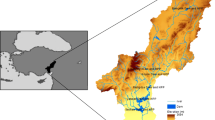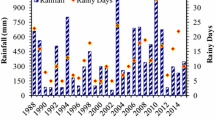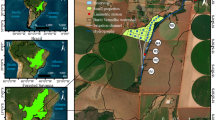Abstract
Using a hydrologic model this study estimated rainwater storages in field-scale on-farm reservoir (OFR) systems at two locations: (1) Fort Worth, Texas, US; (2) Kharagpur, West Bengal, India. The water storages were estimated for variable OFR sizes: 1%, 5%, 10%, 15%, and 25% of the farm area. Water losses through seepage and evaporation were estimated using variable saturated hydraulic conductivity conditions: 0.33, 0.64, 1.3, 5 cm/h, which corresponded to the ranges of hydraulic conductivity of loam, sandy loam, loamy sand, and sandy soils, respectively. Results indicated that the water loss through evaporation was dominant at the first location, while seepage was at the second location. Changing the OFR sizes captured 5 to 28% of the total rainfall received in the farm area of the first location and 20–40% at the second location. Finally, a comparative economic analysis was made between a distributed OFR system and a centralized large reservoir that indicated that the distributed OFR system benefits exceeded the benefits of a large reservoir.
Similar content being viewed by others
References
Aladenola OO, Adeboye OB (2010) Assessing the potential for rainwater harvesting. Water Resour Manage 24(10):2129–2137
Allen RG, Pereira LS, Raes D, Smith M (1998) Crop evapotranspiration: guidelines for computing crop water requirements. FAO Irrigation and Drainage Paper, 56, Rome, 300 pp
Balasubramanian R, Selvaraj KN (2003) Poverty, private property and common pool resource management: the case of irrigation tanks in south India. Working Pap. 2-03, 61 pp, S. Asian Network for Dev and Environ Econ, Kathmandu
Barron J, Rockström J, Gichuki F, Hatibu N (2003) Dry spell analysis and maize yields for two semi-arid locations in East Africa. Agric For Meteorol 117:23–37. doi:10.1016/S0168-1923(03)00037-6
Boyd CE (1982) Hydrology of small experimental ponds at Auburn, Alabama. Trans Am Fish Soc 111:638–644
Cakmak B, Beyribey M, Yildirim YE, Kodal S (2004) Benchmarking performance of irrigation schemes: a case study from Turkey. Irrig Drain 53:155–163. doi:10.1002/ird.130
Clemmens AJ, Allen RG, Burt CM (2008) Technical concepts related to conservation of irrigation and rainwater in agricultural systems. Water Resour Res 44:W00E03. doi:10.1029/2007WR006095
Delclaux F, Coudrain A, Condom T (2007) Evaporation estimation on Lake Titicaca: a synthesis review and modelling. Hydrol Process 21:1664–1677
Demmy GG, Bottcher AB, Nordstedt RA (1993) Measurement of leakage from dairy waste holding ponds. ASAE Paper No. 93-4017. ASAE, St. Joseph
Dey NC, Bala SK, Hayakawa S (2006) Assessing the economic benefits of improved irrigation management: a case study in Bangladesh. Water Policy 8:573–584. doi:10.2166/wp.2006.058
Farnworth M, Petrell RJ (2005) Analysis of pond seepage for application in fisheries and aquaculture. J Am Water Resource Assoc 41:581–590
Green BW, Boyd CE (1995) Water budgets for fish ponds in the dry tropics. Aquacult Eng 14:347–356
Gumbo B, van der Zaag P (2002) Water losses and the political constraints to demand management: the case of the city of Mutare, Zimbabwe. Phys Chem Earth 27:805–813
Hatibu N, Mutabazi K, Senkondo EM, Msangi ASK (2006) Economics of rainwater harvesting for crop enterprises in semi-arid areas of East Africa. Agric Water Manage 80:74–86. doi:10.1016/j.agwat.2005.07.005
Kadlec RH, Knight RL (1995) Treatment wetlands. CRC, Boca Raton
Keller A, Sakthivadivel R, Seckler D (2000) Water scarcity and the role of storage in development, Res. Rep. 39, Int. Water Manage. Inst., Colombo
Malano H, Burton M, Makin I (2004) Benchmarking performance in the irrigation and drainage sector: a tool for change. Irrig Drain 53:119–133. doi:10.1002/ird.126
Massmann JW, Butchart C, Stolar S (2003) Infiltration characteristics, performance, and design of stormwater facilities, Final Research Report, Research Project T1803, Tas k 12. Washington State Department of Transportation, Olympia
McWhorter DB (1985) Seepage in the Unsaturated Zone—a review. In: Richard L (ed) Seepage and leakage from dams and impoundments, Proceedings of a Symposium sponsored by the Geotechnical Engineering Division in conjunction with the ASCE National Convention, Denver, Colorado, 5 May 1985
Mishra A, Adhikary AK, Panda SN (2009) Optimal size of auxiliary storage reservoir for rain water harvesting and better crop planning in a minor irrigation project. Water Resour Manage 23(2):265–288
Molden D (2007) Water for food, water for life: a comprehensive assessment of water management in agriculture. Earthscan, London, 645 pp
Nath SS, Bolte JB (1998) A water budget model for pond aquaculture. Aquacult Eng 18:175–188
National Oceanic and Atmospheric Administration (NOAA) (2010) Washington DC, U.S. (http://www.noaa.gov/about-noaa.html). Accessed 25 Dec 2010
National Solar Radiation Database (NSRD) (2010) National Renewable Energy Laboratory, Golden, Colorado, U.S. (http://rredc.nrel.gov/solar/old_data/nsrdb). Accessed 25 Dec 2010
Pachpute JS, Tumbo SD, Sally H, Mul ML (2009) Sustainability of rainwater harvesting systems in rural catchment of Sub-Saharan Africa. Water Resour Manage 23(13):2815–2839
Pahl-Wostl C (2002) Towards sustainability in the water sector—the importance of human actors and processes of social learning. Aquat Sci 64:394–411. doi:10.1007/PL00012594
Palanisami K, Meinzen-Dick R (2001) Tank performance and multiple uses in Tamil Nadu, south India. Irrig Drain Syst 15:173–195
Pandey PK (2003) Simulation of water balance model for optimum design of on-farm reservoir for rice-fish integration under rainfed ecosystem. Unpublished M. Tech. thesis, Department of Agricultural and Food Engineering, IIT, Kharagpur
Pandey PK, Panda SN, Panigrahi B (2006) Sizing on-farm reservoirs for crop-fish integration in rainfed farming systems in Eastern India. Biosyst Eng 93:475–489
Panigrahi B, Panda SN, Mull R (2001) Simulation of water harvesting potential in rainfed ricelands using water balance model. Agricult Sys 69:165–182
Parker, DB, Auvermann BW, Williams DL (1999) Comparison of evaporation rates from feedyard pond effluent and clear water as applied to seepage predictions. Trans ASAE 42:981–986
Penman HL (1948) Natural evaporation from open water, bare and grass. Proc R Soc Lond Ser A 193:120–145
Penman HL (1963) Vegetation and hydrology. Technical Communication no. 53. Commonwealth Bureau of Soils, Harpenden
Rockström J, Barron J, Fox P (2003) Water productivity in rain-fed agriculture: challenges and opportunities for smallholder farmers in drought-prone tropical agro-ecosystems in water productivity in agriculture: limits and opportunities for improvements. In: Kijne JW, Barker R, Molden D (eds) Compr AssessWater Manage Agric Ser, vol 1, pp 145–162, CABI, Wallingford
Rockström J, Falkenmark M, Karlberg L, Hoff H, Rost S, Gerten D (2009) Future water availability for global food production: the potential of green water for increasing resilience to global change. Water Resour Res 45:W00A12. doi:10.1029/2007WR006767
Shuttleworth WJ (1993) Evaporation. In: Maidment DR (ed) Handbook of hydrology. McGraw-Hill, New York, pp 4.1–4.53
Singh VP, Xu CY (1997) Evaluation and generalization of 13 masstransfer equations for determining free water evaporation. Hydrolog Process 11:311–323
Solar Radiation Hand Book (2008) Typical climatic data for selected radiation stations. Solar Energy Center, MNRE, Indian Metrological Department, India
Szumiec M (1979) Hydrometerology in pond fish culture. In: Pillay TVR (ed) Advances in aquaculture. FAO, Fishing News Books, London, pp 117–120
Takeuchi K (1997) On the scale diseconomy of large reservoirs in land occupation. Sustainability of water resources under increasingly uncertainty (Proceeding of Rabat Symposium), IAHS Publ. No.240, 1997
Teichert-Coddington DR, Peralta M, Phelps RP (1989) Seepage reduction in tropical fish ponds using chicken litter. Aquacult Eng 8:147–154
Turner GM, Baynes TM, Mcinnis BC (2010) A water accounting system for strategic water management. Water Resour Manage 24(3):513–545
U. S. Department of State (2009) Bureau of south and central Asian affairs report http://www.state.gov/r/pa/ei/bgn/3454.htm
United Nations (2005) The Millennium Development Goals Report 2005, New York
United Nations Development Programme (2007) Human development report 2006: beyond scarcity: power, poverty and the global water crisis. Palgrave Macmillan, Basingstoke
US Soil Conservation Service (1972) In: National Engineering Handbook, Section 4, Hydrology. Washington, DC
Valiantzas (2006) Simplified versions for the Penman evaporation equation using routine weather data. J Hydrol 331:690–702
van der Zaag P (2007a) Possibilities and constraints of rainfed agriculture in Africa: securing food stocks by slowing the water flow. Paper presented at NethCID Symposium, Int. Comm. on Irrig. and Drain., Delft, Netherlands, 22 March
van der Zaag P (2007b) Asymmetry and equity in water resources management; critical governance issues for southern Africa. Water Resour Manage 21:1993–2004. doi:10.1007/s11269-006-9124-1
van der Zaag P, Gupta J (2008) Scale issues in the governance of water storage projects. Water Resour Res 44:W10417. doi:10.1029/2007WR006364
World Bank (2004) Water resources sector strategy: strategic directions for World Bank Engagement. Washington, DC
World Bank (2010) Water Resource Management. Washington, D. C. http://web.worldbank.org/WBSITE/EXTERNAL/TOPICS/EXTWAT/0,,contentMDK:21630583~menuPK:4602445~pagePK:148956~piPK:216618~theSitePK:4602123,00.html
Yoo KH, Boyd CE (1994) Hydrology and water supply for pond aquaculture. Chapman & Hall, New York
Author information
Authors and Affiliations
Corresponding author
Rights and permissions
About this article
Cite this article
Pandey, P.K., Soupir, M.L., Singh, V.P. et al. Modeling Rainwater Storage in Distributed Reservoir Systems in Humid Subtropical and Tropical Savannah Regions. Water Resour Manage 25, 3091–3111 (2011). https://doi.org/10.1007/s11269-011-9847-5
Received:
Accepted:
Published:
Issue Date:
DOI: https://doi.org/10.1007/s11269-011-9847-5




